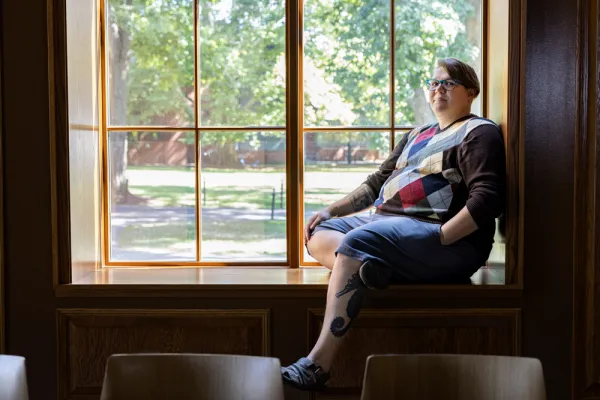A Transgender Educator Reflects on Two Decades of Identity and Visibility in the Classroom
Alum News
Published November 1, 2022
I started teaching right after graduation in 2004. Wanting to break out of the Smith bubble, I took a job in a rural, politically conservative New Hampshire town. Although I was insulated by my whiteness, I was still scared of being harassed or fired for being trans. My response to that fear was to hide. I let my hair grow out. I bought a wardrobe from the women’s department. I went by “Ms. Ambuter.” I have always been gender-nonconforming in some way, but I did not tell anyone at work I was queer, let alone trans, and spent most of the year trying to go unnoticed. I left feeling like I hadn’t been the role model for LGBTQ students that they needed. I knew that if I was going to keep teaching, I had to do something differently.
A few years later, I got a job teaching high school English in Massachusetts. This time I wore a button-up shirt tucked into khakis, and I had freshly cut short hair. But I was still “Ms. Ambuter” and was still afraid of talking about gender at work.
I don’t know how long it would have taken me to come out as trans on my own if a student hadn’t confided in me about their own trans identity. There was no way I was going to let this 10th grader be the first person in the school to negotiate being out as trans. So, on National Coming Out Day in October 2009, I took a nametag, wrote “trans” on it, and stuck it to my shirt.
Over the next decade, I continued to come out in my classrooms. I changed my first name to Ryan. I began using he/him pronouns. I am a gestational parent, and when I was pregnant I taught right up until my due date. He/him pronouns and a visibly pregnant belly felt like a radical contradiction to embody in the classroom.
Teaching as someone who is visibly different requires constant negotiation and hypervigilance. It is hard to be in a classroom—it is hard to be anywhere—when some part of yourself is silenced. When LGBTQ students and teachers are forbidden from talking about gender and sexuality in the classroom, when engaging in content that is deemed “controversial” or “radical” is literally against the law, it is traumatic. It requires disconnection. It inhibits access. I have witnessed brilliant, empowering teachers pushed out of education because the system does not sustain who they are.
As a white transmasculine educator in western Massachusetts, I know I have privilege. When I’ve spoken up about gender with colleagues and administrators, I have mostly been met with something between tolerance and support. Being white provides safety and access. It has made it easier to be out, to challenge norms, to advocate for myself and my students.
Education should show students what is possible. It should center voices and experiences that are marginalized or missing. Sometimes the future of education seems bleak, but in my almost two decades as a trans educator I have found time and again that how we show up matters. I believe that when any teacher who embodies difference stands in their power in the classroom, the hidden curriculum for students is that they can too.
Read More:

Ryan Ambuter ’04 has a master of education in social justice education and a doctorate in teacher education and school improvement from the University of Massachusetts Amherst.
This story appears in the Fall 2022 issue of the Smith Alumnae Quarterly.
“Teaching as someone who is visibly different requires constant negotiation and hypervigilance,” says Ryan Ambuter ’04. Photograph by Jessica Scranton
